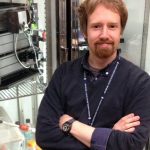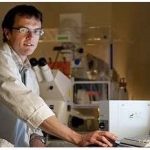5th Anniversary of the V Foundation for Cancer Research Boo-Yah Raises Over $3.1 Million for Disparities in Cancer Research
Read moreType: V Scholar
Designed to identify, retain and further the careers of talented young investigators. Provides funds directly to scientists developing their own independent laboratory research projects. These grants enable talented young scientists to establish their laboratories and gain a competitive edge necessary to earn additional funding from other sources. The V Scholars determine how to best use the funds in their research projects. The grants are $200,000, two-year commitments.
Robert Doebele, M.D., Ph.D.
Mazhar Adli, Ph.D.
Aberrant chromatin regulation is a hallmark of multiple developmental diseases including cancer. Various chromatin marks such as DNA methylation and histone modifications, known as “epigenetic marks”, are implicated in the dynamic regulation of chromatin structure and lineage specific gene expression. Epigenetic regulators are recurrently mutated in cancer. The reversible nature of epigenetic marks holds great therapeutic promise. Therefore much effort is devoted to developing small molecule epigenetic inhibitors however such approaches are targeting the entire genome, causing multiple unintended side effects. I am proposing to develop tools that enable locus-specific manipulation of chromatin structure and function. Bu using such locus specific epigenetic engineering tools, I aim to alter aberrantly regulated local epigenetic modifications at specifically targeted genomic region.
Andrew A. Lane, M.D., Ph.D.
Several common cancers occur more frequently in males than in females, but we do not understand why this is the case. It can’t be simply explained by differences in environmental exposures, like cigarette smoking. Males have two different “sex chromosomes,” called X and Y. Females have two copies of the X chromosome, but no Y. Having XY (males) or XX (females) determines why males and females are different – they look different, make different hormones, and have different roles in passing genes to their children. We think that the X and Y chromosome differences may also influence cancer risk, and explain why some cancers happen more frequently in men.
I am a hematologist/oncologist, and I take care of patients with blood cancers such as leukemia and lymphoma. We were studying blood cancers in the laboratory by sequencing cancer DNA from patients. We found something very surprising: there was a group of patients with mutations in their DNA in a gene that “lives” on the X chromosome, and 100% of those patients were men. We looked in the medical literature and found a few other examples of genes on chromosome X that were mutated in cancers that occur more often in men than women.
In this study, we will look at data from thousands of patients with many types of cancer to see if there is evidence for gene mutations on the X and Y chromosomes that explain some of the difference in cancer incidence between men and women. These findings may be relevant in the many cancers that are more frequent in men, including leukemia, myelodysplastic syndrome, kidney cancer, and bladder cancer. In addition, we will study these genes in the laboratory by deleting one copy in male cells, and one or two copies in female cells. Together, these studies will determine how differences in mutations and number of copies of genes on the X chromosome contribute to cancer. More broadly, we hope that by identifying and characterizing this new kind of cancer gene, we might also discover suggest new ways to prevent and/or treat these types of cancer.
Bjoern Schwer, M.D., Ph.D.
Abeloff V Scholar*
Ben Croker, Ph.D.
Funded by the Dick Vitale Gala
Bone marrow transplantation is commonly used to replace bone marrow stem cells after chemotherapy. However, a return to normal blood production by these stem cells can take several months after transplantation leaving patients vulnerable to infection. We have previously identified a molecular switch that controls life and death decisions in blood stem cells, and we are now seeking to block the death of blood stem cells following transplantation to accelerate the return of normal blood production. This research will also improve our understanding of how leukemia cells evade cell death.
Wenjun Guo, Ph.D.
Cancers are a diverse collection of diseases that are caused by distinct gene mutations. Effective cancer treatment has to be tailored for these patient-specific aberrations. To this end, the cancer genome project has systematically identified mutations in various cancer types and provided a foundation for personalized cancer medicine. However, the cancer genome can be littered with mutations simply due to the fact that cancer cells are highly unstable. Therefore, it is critical to understand which mutations play a causal role in driving cancer progression, i.e. acting as drivers, and which mutations are merely bystanders.
To address this question, we have developed a novel technology for generating personalized breast cancer models that contain mutations found in human patients. Using these models, we will decipher which mutations are functional important, and thus can be useful therapeutic targets. Our work is like to identify novel breast cancer genes and provide new therapeutic targets and biomarkers for selecting most effective treatment.
Successful outcomes of our study will pave the way for developing therapeutic agents for targeting these new breast cancer genes. In addition, the technology perfected through this study will be highly valuable for investigating mutations of other cancer types to identify a catalog of cancer targets that can be tailored for personalized medicine.
Emily Dykhuizen, Ph.D.
Kidney cancer is the 8th most common cancer in the USA, representing 3% of new cancer cases each year and 4% of cancer deaths. Renal cell carcinoma (RCC) is the most common and lethal type of kidney cancer in adults, representing 90-95% of all kidney cancer cases. Approximately 90% of RCCs have mutations in the tumor suppressor gene, von Hippel-Landau (VHL), which is involved in the degradation of hypoxia-inducible factor (HIF) transcription factors. The mutation of VHL leads to huge increases in the levels of HIF, which promotes tumor growth by increasing the blood supply to tumors. Uncovering this pathway of tumor suppression has led to several targeted therapeutics that lower levels of HIF, and are currently used in the clinic. While this has improved the outcome for RCC, the median survival rate for metastatic renal carcinoma patients is still only 22 months. Uncovering additional mechanisms of tumor suppression and new therapeutic targets would bring us closer to our goal of eradicating these cancers. To this end, efforts to identify additional genes mutated in RCC have identified Polybromo-1 (PBRM1) as the second most commonly mutated gene in RCCs (~50%). PBRM1 is part of the SWI/SNF (BAF) chromatin remodeling complex, an important regulator of gene expression. While subunits of the BAF complex are mutated in a spectrum of cancers, mutations in PBRM1 seem to be fairly specific to RCC. We aim to understand the mechanism of tumor suppression by PBRM1 in RCC by 1) uncovering how PBRM1 deletion affects the function of the BAF chromatin remodeling complex, 2) identifying genes regulated by PBRM1 deletion, and 3) identifying pathways important in RCC progression that we can target with novel or known therapeutics.
Agnel Sfeir, Ph.D.
Cancer arises when mutations to our DNA alter the genetic information and change the way our cells normally function. DNA in our body witnesses thousands of lesions on a daily basis. Among these lesions are breaks that occur on both strands of a chromosome, known as double stranded breaks (DSBs), which are highly toxic. In fact, cells in our body have evolved special ways to ensure that when DSBs occur, they are repaired faithfully and promptly to avoid errors in the coding sequence. There are three pathways to repair a DSB in mammalian cells. The preferred pathway is homology-directed repair (HDR) that fixes DNA breaks without altering the original sequence and is hence error-free. DSBs can also be repaired by two additional pathways that are error-prone – the classical Non-Homologous End-Joining (NHEJ) and the alternative NHEJ (alt-NHEJ) pathways. The activity of HDR pathway is absent in many breast cancer cells, and evidence suggests its replacement by the highly mutagenic alt-NHEJ pathway. Hence, the main focus of our proposal is to study the poorly characterized alt-NHEJ pathway of repair and establish its role in breast cancer progression. Using high throughput technology, we plan to uncover novel genes in this pathway and characterize the mechanism by which this repair pathway operates. Ultimately, we will assess the de-regulation of its key components in inherited and sporadic breast cancers. This will provide key steps towards revealing specific targets that can guide more favorable and effective breast cancer treatment strategies.
Omer Yilmaz, M.D., Ph.D.
Funded by Delta Chi Fraternity
The adult mammalian intestine is a rapidly renewing organ that is maintained by stem cells. In order to function properly, these intestinal stem cells often require signals from their cellular neighborhood or “niche”, which consists of Paneth cells. Intestinal cancers often arise from stem cells, yet it is unclear what role the stem cell niche plays in tumor initiation. I will investigate the molecular mechanism of the intestinal stem cell and niche interaction in response to lifespan extending interventions such as calorie restriction, and its relevance to intestinal tumor development.














